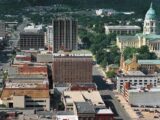
Lack of exercise linked to increased risk of severe COVID-19
August 3, 2021Recent research suggests that consistently meeting physical activity guidelines may reduce the risk of severe COVID-19 outcomes such as hospitalization, ICU admission and death. These findings should encourage physicians and other health care providers worldwide to talk to patients about physical activity — which has been a primary focus for our lab.
As promising as results from these and other similar studies are, an important question remains: Are we making life-saving physical activity accessible for the people who need it most?
Physical activity for all
Statistics Canada’s data on Canadian COVID-19 deaths in 2020 reported at least one comorbidity present in 90 per cent of all COVID-19-related deaths (including younger age groups). A comorbidity is a disease or condition that a patient has at the same time as another illness. Many of the most common comorbid conditions on the list — including high blood pressure, heart disease and diabetes — are linked to physical inactivity.
The list of the most frequent comorbidities is a sign that COVID-19 has disproportionately affected the most vulnerable in our society. It is also an urgent call to change the story now to protect each other and build a healthier, more resilient Canada.
As a part of prevention and treatment of these comorbid conditions that put people at greater risk, access to physical activity for all must play a central part in this change. Physicians and other health care providers can play a part by prescribing physical activity, facilitating access and measuring outcomes.
Social determinants
The reality faced by so many — especially within disadvantaged populations — is that engaging in physical activity is not as simple as it sounds. To be successful, any push for widespread adoption of physical activity to treat and prevent disease must consider the context of individual lives and experiences.
Social determinants of health, specifically socio-economic status, dictate an individual’s ability to be physically active. High-income earners have the resources to lead more active lifestyles and reap the benefits of physical activity while lower-income earners do not.
A single mother working multiple low-wage jobs, for example, may not have the extra resources or leisure time to prioritize physical activity. Low-income neighbourhoods are often characterized by a lack of access to parks and green space. They may also have higher levels of crime, which may make people feel unsafe going outside to exercise.
Given the increased barriers and extra restrictions implemented during the pandemic, physical activity has become much more inaccessible for low-income communities. That may, in turn, place vulnerable populations at a higher risk of severe COVID-19-related complications.
Protecting everyone’s health means addressing barriers that contribute to the widening gap between the advantaged and disadvantaged, including systemic barriers affecting equity-deserving populations such as women, racialized and Indigenous peoples.
Addressing access
Habitual physical activity protects against adverse COVID-19 outcomes, but meeting the Canadian Society for Exercise Physiology’s physical activity guidelines is unattainable for a large portion of the population. Now, more than ever, there is a need to address social inequalities and facilitate participation in physical activity through things like parks, access to facilities and active transport like walking and biking.
Policies, resources and support must consider the impact of socioeconomic factors that limit an individual’s opportunity to exercise. Interventions should aim to avoid exacerbating systemic inequalities, and promote health and well-being for all, including in low socioeconomic communities.
One example of supporting physical activity at the community level is eliminating barriers that inhibit people from walking and cycling, such as improving street connectivity in urban areas where there is poor walkability or lots of traffic.
Why policy change matters now, more than ever
The problem is no longer one of access to information, but of access to infrastructure and resources. In March, Canadian Sen. Chantal Petitclerc and MP Adam Van Koeverden highlighted the central role for physical activity — and more importantly access to physical activity — in what they dubbed Canada’s “active recovery” from COVID-19. To get Canadians moving, they supported prioritizing investments in physical activity and sport participation, and promoting accessibility at the community level. This is welcome news.
The question of access is intimately connected to a host of pre-existing inequalities that the pandemic has shifted into the spotlight. By removing barriers and addressing the underlying social determinants of health, we can ensure that physical activity is accessible to all Canadians.
This is our focus as researchers — to study the barriers to and facilitators of physical activity, then develop and curate resources for physicians and the public (for example, My Active Ingredient) so that we are part of the solution.
The pandemic has given us an unparalleled chance to look at the benefits of physical activity and existing social inequalities in a new light. There is an opportunity to do something now to improve the lives of Canadians today and for generations to come. When physical activity guidelines are relevant and attainable in any context, we can begin to foster an inclusive environment where all Canadians can lead healthy and active lifestyles — and prevent further severe outcomes of current and future pandemics.
This article was originally posted on Lack of exercise linked to increased risk of severe COVID-19


